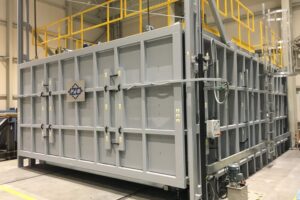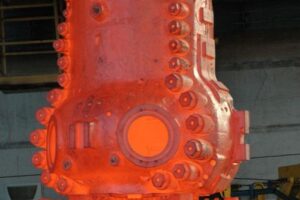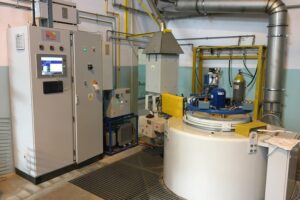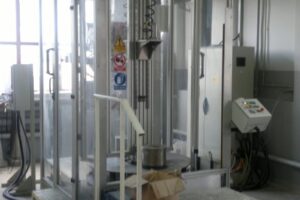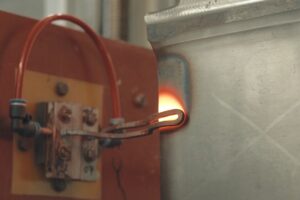Heat treatment and thermo-chemical processing
Thermo-chemical processing is a heat treatment procedure (or a combination of several procedures) aimed at achieving surface properties in the processed material different from those of the core. With years of knowledge and experience in heat treatments and thermo-chemical processes, we continually enhance our machinery park to maintain a high level of services. We invest in the latest technologies and acquire furnaces to meet the evolving demands.
-
Annealing is one of the heat treatment operations for metals, involving heating the material to a specific temperature, holding it at that temperature, and then slowly cooling it down. The objective of the treatment is to bring the material closer to equilibrium conditions.
We have a significant number of chamber resistance furnaces and deep resistance furnaces with automatic temperature control. This allows us to perform softening and stress-relieving annealing after welding and mechanical processing. We can anneal a wide range of materials, such as structural steels, spring steels, heat-resistant steels, stainless steels, cast steels, and gray iron. These processes are carried out for components of small, medium, and large sizes, with maximum dimensions of 1800x5000x7000mm.
-
The goal of normalizing is to impart a uniform, fine-grained structure to the steel. This process is used to achieve a predictable microstructure and ensure specific mechanical properties in semi-finished products (forgings, rolled and forged bars, pipes, and sheets made of carbon and low-alloy steels). Normalized components exhibit greater hardness and strength compared to, for example, annealed steel.
-
Heat treatment is a thermal processing method that combines quenching with high tempering. Heat treatment leads, among other things, to an increase in plastic properties, tensile strength, resistance to cracking, and a decrease in hardness.
We offer heat treatment services in chamber resistance furnaces with automatic temperature control. Heat treatment can be performed for small and medium-sized components with maximum dimensions of 800x600x1600mm. This process is applied to forged, rolled, and wrought bars made of non-alloy and alloy steels. We have our own heat treatment technologies, or we can conduct the process based on parameters specified by the customer.
-
We offer carburizing in solid media, specifically using charcoal powders in chamber resistance furnaces with automatic temperature control. Carburizing can be performed for small and medium-sized components with maximum dimensions of 1000x600x450mm. This process is applied to forged, rolled, drawn, and annealed sheet bars. We carburize structural, alloy, and non-alloy steels.
-
Precipitation hardening is applied to various materials to increase yield strength, thereby enhancing material hardness, wear resistance, and imparting stainless steel-like characteristics. We offer precipitation hardening processes in a chamber resistance furnace with automatic temperature control. Precipitation hardening can be performed for components with maximum dimensions of 650x300x250mm. These processes are conducted for high carbon steels, austenitic steels, and nickel alloys. Precipitation hardening is typically employed for stainless and acid-resistant steels.
-
Gas nitriding technology is particularly recommended for treating machine components and mechanisms operating under dry or boundary friction conditions. We perform gas nitriding in deep chamber resistance furnaces with automatic temperature control. Gas nitriding can be carried out for small, medium, and large components with maximum dimensions of ⌀650×1900mm and a maximum weight of 1200kg. We conduct gas nitriding for a wide range of materials, including steels for nitriding, martensitic steels, stainless steels, low-alloy steels for heat treatment, and austenitic steels. With a modern deep chamber resistance furnace, we can also nitride elements made from materials resistant to nitriding, such as nickel alloys (Inconel).
-
Induction hardening is used to enhance the mechanical properties of specific areas in steel components. The primary advantage of this process is the improvement of mechanical properties in a designated region without the need for redesigning the entire element.
We perform induction hardening for steam turbine blades with standard dimensions up to 1500 mm in height and a weight of up to 50 kg (larger dimensions possible upon consultation). The induction hardening process is carried out at temperatures ranging from 1020°C to 1100°C, followed by cooling in a furnace at approximately 140°C at a rate of < 50 °C/h. After induction hardening, hardness levels up to 600HV can be achieved. It is possible to perform through-hardening or surface hardening only (with the appropriate blade thickness). Blades are secured in three different ways: in anvils, on pins, or on rollers with a profile adapted to the blade root.
-
Nitrocarburizing is a variation of the surface hardening process. This method is employed to enhance the wear resistance of the surface layer of a component and improve its fatigue strength. Gas nitrocarburizing is primarily applied to valve components such as spindles, seats, inserts, spindle heads, diffusers, and pipe ends, especially in areas where telescopic connections are present.
- Annealing
- Normalizing
- Heat treatment
- Carburizing
- Precepitation hardening
- Gas nitriding
- Induction hardening
- Nitrocarburising (bath nitriding)
Annealing is one of the heat treatment operations for metals, involving heating the material to a specific temperature, holding it at that temperature, and then slowly cooling it down. The objective of the treatment is to bring the material closer to equilibrium conditions. We have a significant number of chamber resistance furnaces and deep resistance furnaces with automatic temperature control. This allows us to perform softening and stress-relieving annealing after welding and mechanical processing. We can anneal a wide range of materials, such as structural steels, spring steels, heat-resistant steels, stainless steels, cast steels, and gray iron. These processes are carried out for components of small, medium, and large sizes, with maximum dimensions of 1800x5000x7000mm. |
The goal of normalizing is to impart a uniform, fine-grained structure to the steel. This process is used to achieve a predictable microstructure and ensure specific mechanical properties in semi-finished products (forgings, rolled and forged bars, pipes, and sheets made of carbon and low-alloy steels). Normalized components exhibit greater hardness and strength compared to, for example, annealed steel.
Heat treatment is a thermal processing method that combines quenching with high tempering. Heat treatment leads, among other things, to an increase in plastic properties, tensile strength, resistance to cracking, and a decrease in hardness.
We offer heat treatment services in chamber resistance furnaces with automatic temperature control. Heat treatment can be performed for small and medium-sized components with maximum dimensions of 800x600x1600mm. This process is applied to forged, rolled, and wrought bars made of non-alloy and alloy steels. We have our own heat treatment technologies, or we can conduct the process based on parameters specified by the customer.
We offer carburizing in solid media, specifically using charcoal powders in chamber resistance furnaces with automatic temperature control. Carburizing can be performed for small and medium-sized components with maximum dimensions of 1000x600x450mm. This process is applied to forged, rolled, drawn, and annealed sheet bars. We carburize structural, alloy, and non-alloy steels.
Precipitation hardening is applied to various materials to increase yield strength, thereby enhancing material hardness, wear resistance, and imparting stainless steel-like characteristics. We offer precipitation hardening processes in a chamber resistance furnace with automatic temperature control. Precipitation hardening can be performed for components with maximum dimensions of 650x300x250mm. These processes are conducted for high carbon steels, austenitic steels, and nickel alloys. Precipitation hardening is typically employed for stainless and acid-resistant steels.
Gas nitriding technology is particularly recommended for treating machine components and mechanisms operating under dry or boundary friction conditions. We perform gas nitriding in deep chamber resistance furnaces with automatic temperature control. Gas nitriding can be carried out for small, medium, and large components with maximum dimensions of ⌀650×1900mm and a maximum weight of 1200kg. We conduct gas nitriding for a wide range of materials, including steels for nitriding, martensitic steels, stainless steels, low-alloy steels for heat treatment, and austenitic steels. With a modern deep chamber resistance furnace, we can also nitride elements made from materials resistant to nitriding, such as nickel alloys (Inconel).
Induction hardening is used to enhance the mechanical properties of specific areas in steel components. The primary advantage of this process is the improvement of mechanical properties in a designated region without the need for redesigning the entire element. We perform induction hardening for steam turbine blades with standard dimensions up to 1500 mm in height and a weight of up to 50 kg (larger dimensions possible upon consultation). The induction hardening process is carried out at temperatures ranging from 1020°C to 1100°C, followed by cooling in a furnace at approximately 140°C at a rate of < 50 °C/h. After induction hardening, hardness levels up to 600HV can be achieved. It is possible to perform through-hardening or surface hardening only (with the appropriate blade thickness). Blades are secured in three different ways: in anvils, on pins, or on rollers with a profile adapted to the blade root. |
Nitrocarburizing is a variation of the surface hardening process. This method is employed to enhance the wear resistance of the surface layer of a component and improve its fatigue strength. Gas nitrocarburizing is primarily applied to valve components such as spindles, seats, inserts, spindle heads, diffusers, and pipe ends, especially in areas where telescopic connections are present.
